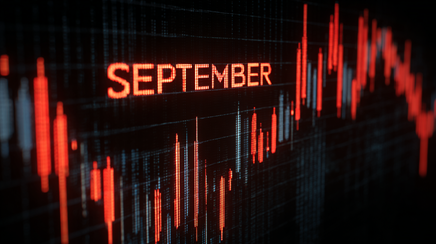September: The Market’s Most Misunderstood Month

Let’s get one thing straight: September has a reputation, and not a great one. Historically, it’s been labeled the worst month for the stock market. Cue the ominous music, right? But let’s not just buy into market mythology. If you’re an active trader, you don’t fear the calendar. You read the signals, follow the data, and stick to your plan.
So, is September really the market’s boogeyman? Or is it an opportunity in disguise? Let’s break it down.
A Quick Look at the Stats
If you go back and look at the historical averages, especially on the S&P 500, you’ll see that September does, on average, post the weakest returns of any month. We’re talking about an average return around -0.7% depending on the timeframe you analyze. Compare that to July or November, which tend to be stronger, and you get why traders tread carefully.
But remember: averages are just that, averages. They don’t tell the whole story. Not every September is a bloodbath, and not every bull run starts in January.
The real value? Understanding why September behaves the way it does.
Why Is September So Sloppy?
A few factors:
- Post-Summer Rebalancing
Institutional traders, hedge funds, and asset managers come back from their summer break ready to reposition. That often means selling off the high-flyers and rotating into more defensive names, or even just taking profits. - Tax-Loss Harvesting Begins Early
Some investors start cutting their losers to offset gains before year-end. That adds pressure to already weak or volatile stocks. - Pre-Q4 Uncertainty
September is sandwiched between lackluster August volume and the high-stakes earnings season in October. Traders start pricing in uncertainty, and that makes the market twitchy. - Fed Jitters
It’s also a favorite month for central bank announcements, rate hikes, balance sheet talk, inflation warnings. And nothing freaks out the market faster than a Fed surprise. Although right now, the fed looks to be lowering rates, in September, and that may change the trajectory!
So yeah, there’s a reason September feels like someone turned the lights off and threw marbles on the floor.
How Should Traders Approach It?
First rule: don’t be passive. September isn’t the time to set and forget. It’s a month where volatility shows up, and for smart traders, that means opportunity.
Here’s how I play it:
- Tighten Stops: This isn’t the month to give trades extra breathing room. Risk management is priority #1.
- Short-Term Mindset: I lean into shorter timeframes, day trades, swing trades, and tactical plays. Holding long in a choppy month is asking to get whipsawed.
- Watch for Institutional Footprints: This is key. September is when the big players start moving the chess pieces. If you know how to spot their buying and selling zones (like we teach at Trading Academy), you’ve got a massive edge.
- Look for Rotation: Sectors will start shifting, money may flow out of tech, into energy, out of growth, into value. Use ETFs to track this and ride the flow.
What’s Happening This September?
Here in 2025, the macro backdrop is doing us no favors. Between inflation headlines, tariff wars, and global tensions (looking at you, BRICS), the market’s already on edge. Add in the recent shift in bond yields and some disappointing earnings guidance from a few big names, and you’ve got the perfect recipe for choppy price action.
But again, that’s not a bad thing for traders. Choppy markets just mean more price movement. And movement = opportunity, if you have a system.
Don’t Trade Blind
Here’s the biggest mistake I see people make in September: They treat it like any other month. They ignore the calendar, they ignore the macro backdrop, and they wing it.
That’s a fast way to lose money.
You need a trading plan. You need a risk management strategy. You need to understand how the institutions think, and more importantly, where they’re likely to act.
That’s what we focus on every day inside the Trading Academy. It’s not about being smarter or faster, it’s about being prepared. It’s about reading price action, recognizing patterns, and executing with discipline.
So, is September a bad month to trade?
Not if you know what you’re doing.
Yes, it’s volatile. Yes, it’s historically underwhelming for long-only investors. But for active traders? It’s full of setups, if you’ve got the tools and the training to spot them.
If you're serious about this game, now’s the time to sharpen your edge. September doesn’t care how confident you are, it cares how prepared you are.
Let the retail crowd panic. You’ve got a playbook.